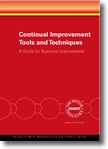 |
A Process is a series of connected steps or actions
to achieve an outcome. Process Maps and flow Charts are the most commonly
used methods for designing and analysing processes and are the most widely
used of all the problem solving tools.
By graphically representing the logical steps of a process, promotes a
greater and shared understanding of 'how the work is done' and this presents
opportunities for identification of problems and non value adding steps,
which can lead to process improvements.
How
to - Flow Chart
The guide includes an overview of flow charts, when to use them, benefits,
the symbols used, different types of flow charts, how to develop and interpret
them; as well as exercises for getting started...
The US Navy Total
Quality Leadership Office
Follow the Map
This article shows how process mapping can be used by the Six Sigma black
belt or green belt to help them in two essential aspects of the Six Sigma
method. The first is in the initial capture of the process where true
understanding of how things are done currently is developed, this being
vital to build an objective case for improving the process. The second
is in the improvement phase itself where it is necessary to prototype,
experiment, communicate and ultimately explain how process improvements
affect the new way of doing things. This article also explains how any
enterprise seeking to document a process can use the distributed process
mapping methodology to get the mapping phase completed quickly and with
the most accurate results, as well as ensuring total staff buy-in and
ownership of the eventual outcome...
Michael Cousins
Triaster
Supporting the Distributed Process
Mapping Approach
This compilation of quotes provided by Triaster presents an unarguable
case for the Distributed Process Mapping Approach whilst highlighting
the power of the internet for research and learning...
Triaster
Process Mapping Gives Great Direction
Process mapping is the first step of process management. It consists of
tools that enable you to document, analyse, improve, streamline and redesign
the way your company performs work. In this article Robert Boehringer
and Paul King provide an overview and a simple example of a process map...
|
A Guide for Business Improvement
|
|
 View larger image
View larger image |
This guide explains how to carry out
more than twenty tools & techniques necessary to ensure your
business continually improves.
Topics covered include:
Affinity diagrams, Bar charts, Black & white charts, Brainstorming,
Cause & effect diagrams, Design of Experiments (DoE), Failure
Mode, Effect and Criticality Analysis (FMEA/FMECA), Fault Tree Analysis
(FTA), Five WHY’s for root cause analysis, Five Ws & one
H for problem definition, Flow charting, Histograms,
Pareto analysis, Pictograms, Pie charts, Plan-Do-Check-Act (PDCA)
cycle, Quality Function Deployment (QFD), Rating, Repeatability
and Reproducibility tests (R&R), Run charts, Significance testing,
Solution effect diagrams
Also includes a handy matrix showing when to apply which tool &
technique. |
| |
| Further reading |

|
The Basics of
Process Mapping
by Robert Damelio |
This book
is short (66 pages) and can be read in under an hour. As the title
says its “The Basics of Process Mapping”. Nevertheless
it provides a handy introduction into the concept of process mapping,
with easy to understand and practical examples. Best of all it’s
cheap enough to buy the whole team a copy. |
| Buy
UK |
Buy
US |
|
Mapping Work Processes
by Dianne Galloway |

|
This best
seller shows how to create flowcharts, which are proven to help
improve any work process. Detailed exercises teach anyone how to
chart and document processes, understand them, and make improvements
from them. This hands-on, step-by-step workbook includes instructions
on how to document work process-requirement for ISO 9000 registration.
Graphics and illustrations are used to help the reader grasp the
fundamentals of mapping quality. Benefits: Use the checklists to
select the process to map * Create a detailed flowchart of your
process * Features 13 techniques to improve the process once a map
is created. |
| Buy
UK |
Buy
US |
|

top of page |
 |
